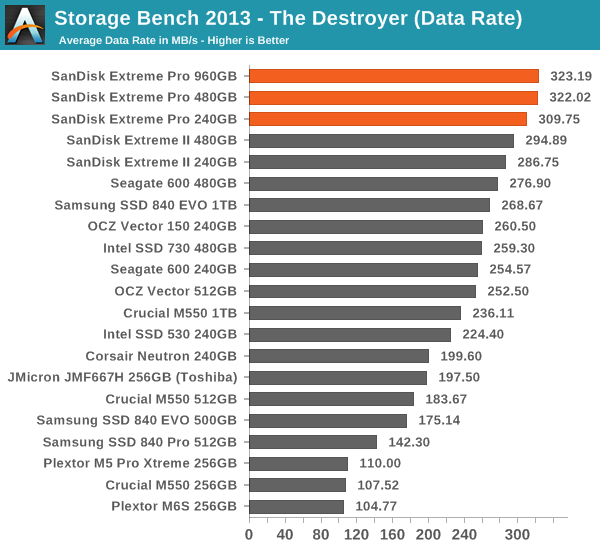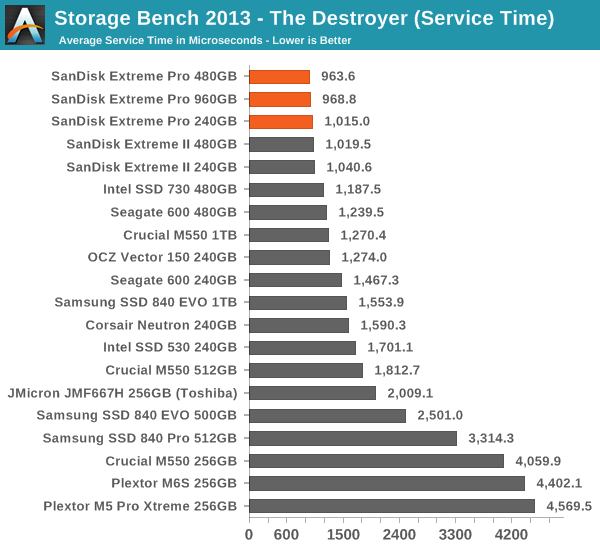SanDisk Extreme Pro SSD (240GB, 480GB & 960GB) Review: The Fastest Just Got Faster
by Kristian Vättö on June 16, 2014 4:00 PM EST- Posted in
- Storage
- SSDs
- SanDisk
- Extreme Pro
AnandTech Storage Bench 2013
Our Storage Bench 2013 focuses on worst-case multitasking and IO consistency. Similar to our earlier Storage Benches, the test is still application trace based - we record all IO requests made to a test system and play them back on the drive we are testing and run statistical analysis on the drive's responses. There are 49.8 million IO operations in total with 1583.0GB of reads and 875.6GB of writes. I'm not including the full description of the test for better readability, so make sure to read our Storage Bench 2013 introduction for the full details.
| AnandTech Storage Bench 2013 - The Destroyer | ||
| Workload | Description | Applications Used |
| Photo Sync/Editing | Import images, edit, export | Adobe Photoshop CS6, Adobe Lightroom 4, Dropbox |
| Gaming | Download/install games, play games | Steam, Deus Ex, Skyrim, Starcraft 2, BioShock Infinite |
| Virtualization | Run/manage VM, use general apps inside VM | VirtualBox |
| General Productivity | Browse the web, manage local email, copy files, encrypt/decrypt files, backup system, download content, virus/malware scan | Chrome, IE10, Outlook, Windows 8, AxCrypt, uTorrent, AdAware |
| Video Playback | Copy and watch movies | Windows 8 |
| Application Development | Compile projects, check out code, download code samples | Visual Studio 2012 |
We are reporting two primary metrics with the Destroyer: average data rate in MB/s and average service time in microseconds. The former gives you an idea of the throughput of the drive during the time that it was running the test workload. This can be a very good indication of overall performance. What average data rate doesn't do a good job of is taking into account response time of very bursty (read: high queue depth) IO. By reporting average service time we heavily weigh latency for queued IOs. You'll note that this is a metric we have been reporting in our enterprise benchmarks for a while now. With the client tests maturing, the time was right for a little convergence.

Given that the Extreme II was already dominating the Storage Bench 2013, it doesn't come as a surprise that the Extreme Pro is the new crownholder. Even the SSD 730 and Vector 150 can't challenge the Extreme Pro despite the fact that in terms of pure random write performance they are better. I think SanDisk's strength lies in mixed read/write performance because write performance alone does not yield good results in real world workloads, which tend to be a mix of reads and writes.
In fact, client workloads (like our Storage Benches) are usually more read-centric anyway and in the case of the Extreme Pro, the drive spent over three times longer processing read IOs than write IOs, which makes sense because there are nearly four times more read IOs than there are write IOs in the trace (even though in terms of gigabytes the difference is only twofold).











85 Comments
View All Comments
Kristian Vättö - Tuesday, June 17, 2014 - link
Unfortunately the tool we use doesn't allow the LBA range to be limited.uruturu - Wednesday, June 18, 2014 - link
:( I think would have been a head-to-head between Sandisk Extreme Pro, Samsung 840 Pro and Corsair Neutron GTX...sheh - Tuesday, June 17, 2014 - link
It's good to see also the lower capacity model performing well. I hope other manufacturers would do the same. But too bad there's no 120GB."SanDisk is betting that its target users will ... or the endurance limit will be hit after the warranty runs out"
Is the warranty not 10 years or 80TB, whichever comes first?
Kristian Vättö - Tuesday, June 17, 2014 - link
Yes. The warranty will be voided if you exceed the 80TB write limit.hojnikb - Tuesday, June 17, 2014 - link
wow, i never though there are products with 32!!! stacked dies.is there any specific product, that uses so much dies ?
prophet001 - Tuesday, June 17, 2014 - link
I was wondering why there was no mention of block size. Do you set the block size on these drives? If so, does it make a difference in the performance?Demon-Xanth - Tuesday, June 17, 2014 - link
What's going to keep PCIe SSD adoption low is the sheer number of systems that you can't just drop it in and boot in it's current state. What it will likely take is for the drives to ship with a legacy mode that says to BIOS "yeah... I'm a SATA RAID controller with a bunch of drives attached...". The latest EFI updates for NVE and Windows 8.1 are a great step forward though.zuiop - Tuesday, June 17, 2014 - link
Can somebody explain to me why in most SSD reviews the lack of encryption support is criticised? Of course you want encryption for your data, but why in the drive? It's a black box implementation that you can't fully trust or update, unlike the plenty of open source software solutions. Especially when talking about high performance drives, I'd expect the CPU to have hardware acceleration for encryption, so speed shouldn't be an issue afaict. Can anybody shed some light on this?Kristian Vättö - Tuesday, June 17, 2014 - link
Software encryption adds unnecessary overhead and thus degrades performance:http://www.anandtech.com/show/6891/hardware-accele...
I think I need to do an article that better describes the usefulness of TCG Opal because there are some security advantages as well. I admit that we probably haven't done the best to fully address this, but hopefully we can still fix it :)
zuiop - Tuesday, June 17, 2014 - link
Thanks for your reply. I'd love to see the article. I couldn't see from that linked article whether the CPU has AES NI or equivalent, my point is that I can't see why encrypting the data with such a CPU is inferior to drive side encryption. I'm looking forward to the article!